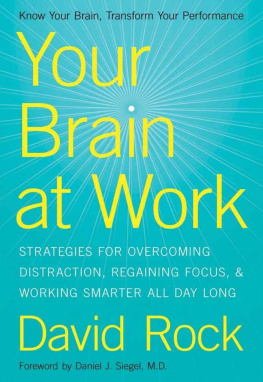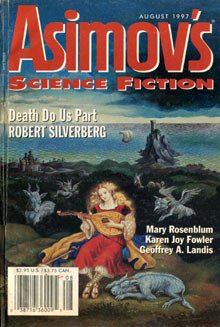Strategies for Overcoming Distraction, Regaining Focus, and Working Smarter All Day Long
Contents
Problems and Decisions
The Morning Email Overwhelm
A Project That Hurts to Think About
Juggling Five Things at Once
Saying No to Distractions
Searching for the Zone of Peak Performance
Getting Past a Roadblock
Meet the Director
Stay Cool Under Pressure
Derailed by Drama
Drowning amid Uncertainty
When Expectations Get Out of Control
Collaborate with Others
Turning Enemies into Friends
When Everything Seems Unfair
The Battle for Status
Facilitate Change
When Other People Lose the Plot
The Culture That Needs to Transform
W hen I first read the manuscript for Your Brain at Work , I asked David Rock if I could share it with my wife and two teenagers. The writing is clear, the ideas transformative, and the setup fabulous: Scenes are played out in normal day-today work and home life, then the same situation is reenacted when the characters have learned to think and behave with the brain in mind. When theyve developed the ability to understand their minds more deeplyto have what I call mindsightthey have a conscious choice over how to engage their brains, and now have the power to change their habits.
The mindhow we regulate the flow of energy and informationuses the brain to create itself. For this reason, the emerging science of the brain is a natural place to develop more effective strategies for improving life at work. David Rock has taken challenging areas of neuroscience and cognition and interpreted them in an accurate yet highly accessible manner. He has interviewed scientists directly, visiting their laboratories, and has spent hundreds of hours culling the latest findings to extract the most current understanding of how the mind and brain influence our lives.
The suggestions here are powerful tools, based on rigorous science, for helping people throughout the workforce. If you are a frontline employee, the stories and science in this book will help you become more effective in your work and avoid burnout. If you are a manager, the information offered here will enable you to delegate with more skill and juggle various projects with more success. And if you are in a leadership position, knowing about the brain can help you create an organizational structure that inspires your employees to take pride in their work, bring more attention and resourcefulness to their tasks, and work more collaboratively with their peers.
Learning to live with the brain in mind is a powerful way to strengthen your mind and improve your professional life. With more ability to regulate the flow of energy and information in your work, you can become more effective and achieve a greater sense of satisfaction. David Rock is just the right guide for bringing the brain to work. We can all thank him for sharing his hard-earned insightsand wonderful sense of humor.
Daniel J. Siegel, M.D., clinical professor at UCLA School of
Medicine; co-director of the UCLA Mindful Awareness
Research Center; director, Mindsight Institute; and author of
Mindsight: The New Science of Personal Transformation;
The Mindful Brain: Reflection and Attunement
in the Cultivation of Well-Being; and The Developing Mind
A n avalanche of emails.
An overload of information.
A meeting schedule that leaves you exhausted.
Ever more change and uncertainty.
The occasional win just to keep you going.
If this sounds like your average day at work, youve picked up the right book.
This book will help you work smarter, be more focused and productive, stay cool under pressure, reduce the length of meetings, and even tackle the hardest challenge of all: influencing other people. Along the way it may help you be a better parent and partner, and perhaps even live longer. It will even make coffee for you. Okay, maybe not that last bit, but everything else I mean quite seriously.
This book will transform your performance at work by letting you in on recent and important discoveries about the human brain. Youll have the chance to get more focused and productive by understanding your own brain at workat work. Its only through knowing your brain that you can change it. (How your brain can change by understanding itself is something you will learn about here, too.)
I know a lot about how easily brains can get overwhelmed, so I have no intention of drowning you in complicated science here. Instead, in this book youll get to know your brain in a way that brains like: by reading a story. This story involves two characters, Emily and Paul, as they experience a set of challenges over a single day at work. As you watch Emily and Paul go through their day, some of the smartest neuroscientists in the world will explain why they struggle with their email, schedules, and colleagues. Even better, you will also get to see what Emily and Paul might have done differently if theyd understood their brains better.
Before I explain how this book is organized, let me give you a little background as to how this all came about. I am not a neuroscientist. I am a business consultant. I help organizations such as Accenture, EDS, Ericsson, and NASA improve their peoples performance. Over the course of a decade of this work, Ive discovered, somewhat by accident, that teaching employees about their brains made a big difference to their performance, and often to their lives, too. When I couldnt find a book that explained the most useful discoveries about the brain in simple language for people at work, I decided to write one.
This book took three years to put together, though I had been developing parts of it for several years longer. It is based on interviews with thirty leading neuroscientists from the United States, Europe, and Asia-Pacific, and it draws from more than three hundred research papers based on thousands of brain and psychological studies done over recent years. While writing this book, I had a scientific mentor help me wade through the research, neuroscientist Dr. Jeffrey M. Schwartz. I also convened three summits about the brain in the workplace: in Italy, Australia, and the United States. Out of those summits, I helped create an academic journal and gave hundreds of lectures and workshops across the globe. The ideas in this book emerged out of a combination of all of these activities.
Enough about me. Lets explore how the book is organized. I wanted this book to be useful to people. Thats tricky when youre dealing with the most complex thing in the known universe, the human brain. After several attempts to explain the brain in different ways, I decided to structure this book like a play.
The play has four acts. The first two acts are about your own brain. The second two acts focus on interacting with other peoples brains. There is also an intermission, which explores some of the deeper themes emerging out of the story.
Act 1 is called Problems and Decisions, and involves the fundamentals of thinking. Act 2, Stay Cool Under Pressure, explores emotions and motivations and the impact of these on thinking. Act 3, Collaborate with Others, introduces research on how we might all get along better. Act 4, Facilitate Change, focuses on how to create change in others, one of the hardest things to do.
Each act has several scenes, and each scene begins with Emily or Paul facing a challenge at work or at home, such as dealing with an avalanche of emails. I chose the characters particular daily challenges by gathering information, with an online survey I created, from more than one hundred people who might end up reading this book. I then combined the resulting data with research from surveys of organizational culture.












